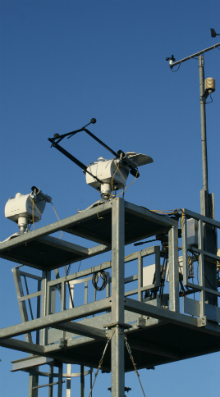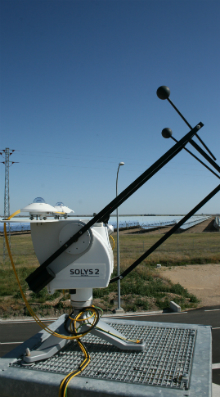We asked Ruud Ringoir, Product Manager of solar instruments at Kipp & Zonen, to explain the maintenance steps to ensure that a solar monitoring station provides reliable measurement data.
 What is needed for the correct monitoring of solar radiation at a solar energy plant?
What is needed for the correct monitoring of solar radiation at a solar energy plant?
A complete solar monitoring station consists of a pyrheliometer to measure direct normal irradiance (DNI), a pyranometer to measure global horizontal irradiance (GHI) and a shaded pyranometer to measure diffuse horizontal irradiance (DHI). These instruments are mounted on a sun tracker that follows the sun the whole day and provide information about solar radiation available at the site.
For PV installations a tilted pyranometer mounted at the same angle as the PV panels is essential to monitor their performance and is always added to the solar monitoring station. A pyrgeometer is often added to a monitoring station for CSP (Concentrated Solar Power) plants to measure infrared radiation from the atmosphere. An additional weather station with sensors for temperature, wind and precipitation also gives information for analysis of the plant performance.
For larger plants two measurement sites are required to provide reliable data across the site and redundancy of the measurements.
What are the main issues to be considered when installing a solar monitoring station?
Ideally the solar monitoring station should have an unobstructed field of view. This means that there should be no shadows during the whole day and no objects, trees or buildings blocking the light from the instruments. Sometimes it is necessary to install the monitoring station at some height above the ground.
The base of the monitoring station has to be stable; a concrete or sturdy steel platform is the best choice. The monitoring station has to be protected from damage that can be caused by people or animals at the site, so a secure fence is a good idea.
What maintenance is required for reliable operation of a solar monitoring station?
 Periodically clean the glass domes and windows of the instruments as dirt will significantly reduce the reliability of the data. The glass domes must be cleaned with clean water or alcohol and never with industrial cleaning liquids and soaps as that will leave residual films on the surface which might affect optical properties of the dome. Preferably use a special microfiber cloth, as supplied with Kipp & Zonen instruments, to gently clean the surface without leaving particles or scratches on the dome. Using ventilation units helps to reduce contamination of the instruments.
Periodically clean the glass domes and windows of the instruments as dirt will significantly reduce the reliability of the data. The glass domes must be cleaned with clean water or alcohol and never with industrial cleaning liquids and soaps as that will leave residual films on the surface which might affect optical properties of the dome. Preferably use a special microfiber cloth, as supplied with Kipp & Zonen instruments, to gently clean the surface without leaving particles or scratches on the dome. Using ventilation units helps to reduce contamination of the instruments.
The instruments must stay dry inside so the desiccant must be replaced periodically. It will change colour when replacement is due, typically every 6 months. Always make sure that the thread of the drying cartridge and the sealing ring are free from sand or dirt when you replace it, to ensure that the instrument is air-tight. Correct leveling of the instruments and alignment of the pyrheliometer must be periodically checked.
Modern sun trackers do not need maintenance, while older models might need annual oiling of gears or adjustment of the internal clock if the tracker does not have automatic correction using GPS data.
We hope that these tips will help you to maintain your performance monitoring station at a high level, thus assuring the best functioning of your solar energy plant.